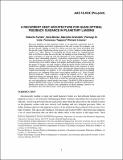Notice
This is not the latest version of this item. The latest version can be found at:https://dspace.mit.edu/handle/1721.1/137763.2
A recurrent deep architecture for quasi-optimal feedback guidance in planetary landing
| dc.date.accessioned | 2021-11-08T18:28:49Z | |
| dc.date.available | 2021-11-08T18:28:49Z | |
| dc.date.issued | 2020-01 | |
| dc.identifier.uri | https://hdl.handle.net/1721.1/137763 | |
| dc.description.abstract | © 2020, Univelt Inc. All rights reserved. Precision landing on large planetary bodies is an important technology that enables future human and robotic exploration of the solar system. For example, over the past decade, landing systems for robotic missions have been developed with the specific goal of deploying robotic agents (e.g. rovers, landers) on the planetary surface (e.g. Mars, Moon). Considering the strong interest for sending humans back to the Moon within the next decade, the landing system technology will continue to progress to keep up with the demand for more stringent requirements. Indeed, more demanding planetary exploration requirements implies a technology development program that calls for more precise guidance systems capable of delivering rovers and/or landers with higher and higher degree of precision. In this paper we design, test and validate a deep Recurrent Neural Network (RNN) architecture capable of predicting the fuel-optimal thrust from sequence of states during a powered planetary descent. Here, the principle behind imitation learning (super-vised learning) are applied. A set of propellant-optimal open loop landing trajectories are computed using direct transcription methods (e.g. Gauss Pseudo Spectral methods). Such sequences comprise the training set (i.e. the teacher) employed during the learning phase. A Long-Short Term Memory (LSTM) architecture is employed to keep track of what has entered the network before and use such information to better predict the output. The RNN-LSTM architecture is trained validated and tested to evaluate the performance predictive performance. Finally, the results of a Monte Carlo simulations in Moon landing scenarios are provided to show the effectiveness of the proposed methodology. | en_US |
| dc.language.iso | en | |
| dc.rights | Creative Commons Attribution-Noncommercial-Share Alike | en_US |
| dc.rights.uri | http://creativecommons.org/licenses/by-nc-sa/4.0/ | en_US |
| dc.source | MIT web domain | en_US |
| dc.title | A recurrent deep architecture for quasi-optimal feedback guidance in planetary landing | en_US |
| dc.type | Article | en_US |
| dc.identifier.citation | 2020. "A recurrent deep architecture for quasi-optimal feedback guidance in planetary landing." Advances in the Astronautical Sciences, 170. | |
| dc.relation.journal | Advances in the Astronautical Sciences | en_US |
| dc.eprint.version | Author's final manuscript | en_US |
| dc.type.uri | http://purl.org/eprint/type/ConferencePaper | en_US |
| eprint.status | http://purl.org/eprint/status/NonPeerReviewed | en_US |
| dc.date.updated | 2021-05-06T12:08:14Z | |
| dspace.orderedauthors | Furfaro, R; Bloise, I; Orlandelli, M; Di Lizia, P; Topputo, F; Linares, R | en_US |
| dspace.date.submission | 2021-05-06T12:08:18Z | |
| mit.journal.volume | 170 | en_US |
| mit.license | OPEN_ACCESS_POLICY | |
| mit.metadata.status | Authority Work and Publication Information Needed | en_US |
